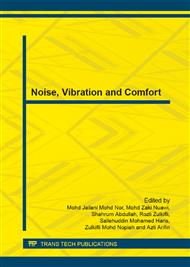[1]
A. Singh, M. Syal, S.C. Grady, S. Korkmaz, Effects of Green Buildings on Employee Health and Productivity, American Journal of Public Health 100 (2010) 1665-1668.
DOI: 10.2105/ajph.2009.180687
Google Scholar
[2]
C. Salter, K. Powell, D. Begault, R. Alvarado, Case studies of a method for predicting speech privacy in the contemporary workplace. Berkeley, CA: Center for the Built Environment, University of California (2003).
Google Scholar
[3]
J.S. Bradley. A renewed look at open office acoustical design, The 32nd International Congress and Exposition on Noise Control Engineering, Seogwipo, Korea (2003).
Google Scholar
[4]
P. Leather, D. Beale, L. Sullivan, Noise, psychosocial stress and their interaction in the workplace, Journal of Environmental Psychology 23 (2003) 213-222.
DOI: 10.1016/s0272-4944(02)00082-8
Google Scholar
[5]
G.W. Evans, D. Johnson, Stress and open-office noise, Journal of Applied Psychology 85 (2000) 779-783.
Google Scholar
[6]
M. Hodgson, Acoustical evaluation of six green, office buildings, Journal of Green Building 3 (2008) 108-118.
DOI: 10.3992/jgb.3.4.108
Google Scholar
[7]
K.L. Jensen, E. Arens, L. Zagreus, Acoustical quality in office workstations, as assessed by occupant surveys, Proceedings of Indoor Air 2005, Beijing, China (2005).
Google Scholar
[8]
Information on http: /www. epa. gov/greenbuilding.
Google Scholar
[9]
G.A. Coudriet, Acoustical challenges posed by sustainable building design, Inter-Noise 2009, Ottawa, Canada.
Google Scholar
[10]
S. Abbaszadeh, L. Zagreus, D. Lehrer, C. Huizenga, Occupant satisfaction with indoor environmental quality in green buildings, Proceeding of Healthy Buildings, Lisbon, Portugal, (2009).
Google Scholar
[11]
USGBC. LEED 2009 for New Construction and Major Renovations Rating System. Washington DC: U.S. Green Building Council (Updated 2012).
Google Scholar
[12]
W. Cavanaugh, Introduction to Architectural Acoustics and Basic Principles, in W.J. Cavanaugh, J.A. Wilkes, Architectural Acoustics: Principles and Practice, John Wiley & Sons, Inc., Canada , 1999, pp.1-54.
Google Scholar
[13]
Z. Maekawa, J.H. Rindel, P. Lord. Environmental and architectural acoustics, second ed., Spon Press, Abingdon, Oxon, (2011).
Google Scholar
[14]
G.R. Newsham and Institute for Research in Construction, Making the open-plan office a better place to work: Institute for Research in Construction, National Research Council of Canada (2003).
Google Scholar
[15]
J. Hesedahl, D.C. Bruck. Acoustics and leadership in energy and environmental design - current status and future directions. Inter-Noise 2009, Ottawa, Canada.
Google Scholar
[16]
C.D. Field, J. Digerness, Acoustic design criteria for naturally ventilated buildings, Journal of the Acoustical Society of America 123 (2008) 3814.
DOI: 10.1121/1.2935546
Google Scholar
[17]
C. Field. Acoustic Design in Green Buildings, ASHRAE Journal, 50 (2008) 60-70.
Google Scholar
[18]
M.H.F. de Salis, D.J. Oldham, S. Sharples. Noise control strategies for naturally ventilated buildings, Building and Environment 37 (2002) 471-484.
DOI: 10.1016/s0360-1323(01)00047-6
Google Scholar
[19]
S.N. Kamaruzzaman, N.A. Sabrani, The effect of indoor air quality (IAQ) towards occupants' psychological performance in office buildings, Jurnal Rekabentuk dan Binaan 4 (2011) 49-61.
Google Scholar
[20]
R.T. Muehleisen. Acoustics of Green Buildings (2010). Retrieved 10th April 2012, from http: /www. informedesign. org/_news/jan_v08. pdf.
Google Scholar


